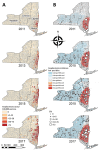Epidemiology and Spatial Emergence of Anaplasmosis, New York, USA, 2010‒2018
- PMID: 34287128
- PMCID: PMC8314826
- DOI: 10.3201/eid2708.210133
Epidemiology and Spatial Emergence of Anaplasmosis, New York, USA, 2010‒2018
Abstract
Human granulocytic anaplasmosis, a tickborne disease caused by the bacterium Anaplasma phagocytophilum, was first identified during 1994 and is now an emerging public health threat in the United States. New York state (NYS) has experienced a recent increase in the incidence of anaplasmosis. We analyzed human case surveillance and tick surveillance data collected by the NYS Department of Health for spatiotemporal patterns of disease emergence. We describe the epidemiology and growing incidence of anaplasmosis cases reported during 2010-2018. Spatial analysis showed an expanding hot spot of anaplasmosis in the Capital Region, where incidence increased >8-fold. The prevalence of A. phagocytophilum increased greatly within tick populations in the Capital Region over the same period, and entomologic risk factors were correlated with disease incidence at a local level. These results indicate that anaplasmosis is rapidly emerging in a geographically focused area of NYS, likely driven by localized changes in exposure risk.
Keywords: Anaplasma phagocytophilum; Ixodes scapularis; New York; United States; anaplasmosis; bacteria; epidemiology; geographical information systems; public health surveillance; space‒time clustering; spatial emergence; spatio-temporal analysis; tick-borne diseases; tick-borne infections; ticks; zoonoses.
Figures



Similar articles
-
Associations of Anaplasma phagocytophilum Bacteria Variants in Ixodes scapularis Ticks and Humans, New York, USA.Emerg Infect Dis. 2023 Mar;29(3):540-50. doi: 10.3201/eid2903.220320. Emerg Infect Dis. 2023. PMID: 36823761 Free PMC article.
-
A Comparative Spatial and Climate Analysis of Human Granulocytic Anaplasmosis and Human Babesiosis in New York State (2013-2018).J Med Entomol. 2021 Nov 9;58(6):2453-2466. doi: 10.1093/jme/tjab107. J Med Entomol. 2021. PMID: 34289040 Free PMC article.
-
Detection of Borrelia miyamotoi and other tick-borne pathogens in human clinical specimens and Ixodes scapularis ticks in New York State, 2012-2015.Ticks Tick Borne Dis. 2017 Mar;8(3):407-411. doi: 10.1016/j.ttbdis.2017.01.004. Epub 2017 Jan 16. Ticks Tick Borne Dis. 2017. PMID: 28131594
-
Anaplasma marginale and Anaplasma phagocytophilum: Rickettsiales pathogens of veterinary and public health significance.Parasitol Res. 2015 Nov;114(11):3941-57. doi: 10.1007/s00436-015-4698-2. Epub 2015 Sep 7. Parasitol Res. 2015. PMID: 26346451 Review.
-
Opening the black box of Anaplasma phagocytophilum diversity: current situation and future perspectives.Front Cell Infect Microbiol. 2015 Aug 14;5:61. doi: 10.3389/fcimb.2015.00061. eCollection 2015. Front Cell Infect Microbiol. 2015. PMID: 26322277 Free PMC article. Review.
Cited by
-
Epidemiological, clinical, and laboratory characteristics of human granulocytic anaplasmosis in North India.J Clin Microbiol. 2024 Mar 13;62(3):e0104823. doi: 10.1128/jcm.01048-23. Epub 2024 Feb 8. J Clin Microbiol. 2024. PMID: 38329335 Free PMC article.
-
Identification of an unusual cluster of human granulocytic anaplasmosis in the Estrie region, Québec, Canada in 2021.Can Commun Dis Rep. 2022 May 5;48(5):188-195. doi: 10.14745/ccdr.v48i05a02. eCollection 2022 May 5. Can Commun Dis Rep. 2022. PMID: 38090114 Free PMC article.
-
Associations of Anaplasma phagocytophilum Bacteria Variants in Ixodes scapularis Ticks and Humans, New York, USA.Emerg Infect Dis. 2023 Mar;29(3):540-50. doi: 10.3201/eid2903.220320. Emerg Infect Dis. 2023. PMID: 36823761 Free PMC article.
-
From Tick to Test: A Comprehensive Review of Tick-Borne Disease Diagnostics and Surveillance Methods in the United States.Life (Basel). 2023 Oct 13;13(10):2048. doi: 10.3390/life13102048. Life (Basel). 2023. PMID: 37895430 Free PMC article. Review.
-
Anaplasmosis-Related Fatality in Vermont: A Case Report.Vector Borne Zoonotic Dis. 2022 Mar;22(3):188-190. doi: 10.1089/vbz.2021.0095. Epub 2022 Mar 9. Vector Borne Zoonotic Dis. 2022. PMID: 35263192 Free PMC article.
References
-
- Guzman N, Yarrarapu SN, Beidas SO. Anaplasma phagocytophilum. Treasure Island (FL): StatPearls Publishing; 2021. [cited 2021 Mar 10]. https://www.ncbi.nlm.nih.gov/books/NBK513341 - PubMed
Publication types
MeSH terms
Grants and funding
LinkOut - more resources
Full Text Sources
Medical

